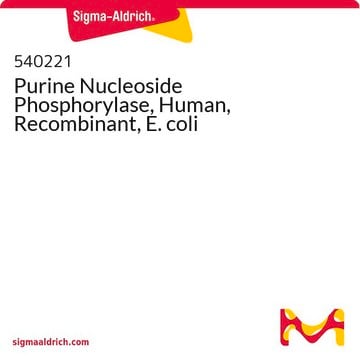DUO92102
Duolink® In Situ Orange Starter Kit Mouse/Rabbit
Sinónimos:
in situ Proximity Ligation Assay reagent, Protein Protein Interaction Assay reagent
About This Item
Productos recomendados
product line
Duolink®
technique(s)
proximity ligation assay: suitable
fluorescence
λex 554 nm; λem 576 nm (orange) (Cyanine 3; Zeiss Filter set 20)
suitability
suitable for fluorescence
storage temp.
−20°C
Application
Follow the Duolink® In Situ Fluorescence Protocol to use this product. A set of short instructionsis also available.
Visit our Duolink® PLA Resource Center for information on how to run a Duolink® experiment, applications, troubleshooting, and more.
To perform a complete Duolink® PLA in situ experiment you will need two primary antibodies (PLA, IHC, ICC or IF validated) that recognize two target epitopes.This starter kit supplies all other necessary reagents for 30 Duolink® PLA reactions, which include a pair of PLA probes (Anti-Rabbit PLUS and Anti-Mouse MINUS), orange detection reagents, wash buffers, and mounting medium.Note that the primary antibodies must come from the same species as the Duolink® PLA probes. Analysis is carried out using standard immunofluorescence assay equipment.
The Duolink® In Situ Orange Starter Kit Mouse/Rabbit requires one primary antibody from mouse and one primary antibody from rabbit. Orange fluorescence detection reagents are often used with Cyanine 3 filter.
Application Note
Two primary antibodies raised in different species are needed. Test your primary antibodies (IgG-class, mono- or polyclonal) in a standard immunofluorescence (IF), immunohistochemistry (IHC) or immunocytochemistry (ICC) assay to determine the optimal fixation, blocking, and titer conditions. Duolink® PLA in situ reagents are suitable for use on fixed cells, cytospin cells, cells grown on slide, formalin-fixed, paraffin embedded (FFPE), or tissue (fresh or frozen). No minimum number of cells is required.
Let us do the work for you, learn more about our Custom Service Program to accelerate your Duolink® projects
View full Duolink® product list
Features and Benefits
- No overexpression or genetic manipulation required
- High specificity (fewer false positives)
- Single molecule sensitivity due to rolling circle amplification
- Relative quantification possible
- No special equipment needed
- Quicker and simpler than FRET
- Increased accuracy compared to co-IP
- Publication-ready results
Legal Information
Los componentes del kit también están disponibles por separado
- DUO92002Duolink® In Situ PLA® Probe Anti-Rabbit PLUS, Affinity purified Donkey anti-Rabbit IgG (H+L)SDS
- DUO92004Duolink® In Situ PLA® Probe Anti-Mouse MINUS, Affinity purified Donkey anti-Mouse IgG (H+L)SDS
- DUO92007Duolink® In Situ Detection Reagents OrangeSDS
- DUO82049Duolink® In Situ Wash Buffers, FluorescenceSDS
- DUO82040Duolink® In Situ Mounting Medium with DAPISDS
signalword
Danger
hcodes
Hazard Classifications
Aquatic Chronic 2 - Met. Corr. 1 - Resp. Sens. 1 - Skin Sens. 1
Storage Class
8A - Combustible corrosive hazardous materials
wgk_germany
WGK 3
Certificados de análisis (COA)
Busque Certificados de análisis (COA) introduciendo el número de lote del producto. Los números de lote se encuentran en la etiqueta del producto después de las palabras «Lot» o «Batch»
¿Ya tiene este producto?
Encuentre la documentación para los productos que ha comprado recientemente en la Biblioteca de documentos.
Los clientes también vieron
Artículos
Conozca cómo funciona la tecnología de análisis de ligadura de proximidad y cómo el kit de control de interacción proteína-proteína puede confirmar la detección in situ de la dimerización EGFR-HER2 inducida por EGF.
Conozca cómo funciona la tecnología de análisis de ligadura de proximidad y cómo el kit de control de interacción proteína-proteína puede confirmar la detección in situ de la dimerización EGFR-HER2 inducida por EGF.
Conozca cómo funciona la tecnología de análisis de ligadura de proximidad y cómo el kit de control de interacción proteína-proteína puede confirmar la detección in situ de la dimerización EGFR-HER2 inducida por EGF.
Duolink® proximity ligation assay used to study neuron interactions furthering neuroscience research.
Protocolos
This page details the Duolink® In Situ Short Protocol for fluorescence detection
This protocol describes how to perform immunofluorescent detection of proteins in cells and tissue.
Contenido relacionado
Protein and nucleic acid interaction reagents and resources for investing protein-RNA, protein-DNA, and protein-protein interactions and associated applications.
Reactivos y recursos de interacción entre proteínas y ácidos nucleicos para investigar las interacciones proteína-ARN, proteína-ADN proteínas-proteínas, y las aplicaciones asociadas.
Reactivos y recursos de interacción entre proteínas y ácidos nucleicos para investigar las interacciones proteína-ARN, proteína-ADN proteínas-proteínas, y las aplicaciones asociadas.
Reactivos y recursos de interacción entre proteínas y ácidos nucleicos para investigar las interacciones proteína-ARN, proteína-ADN proteínas-proteínas, y las aplicaciones asociadas.
Nuestro equipo de científicos tiene experiencia en todas las áreas de investigación: Ciencias de la vida, Ciencia de los materiales, Síntesis química, Cromatografía, Analítica y muchas otras.
Póngase en contacto con el Servicio técnico












